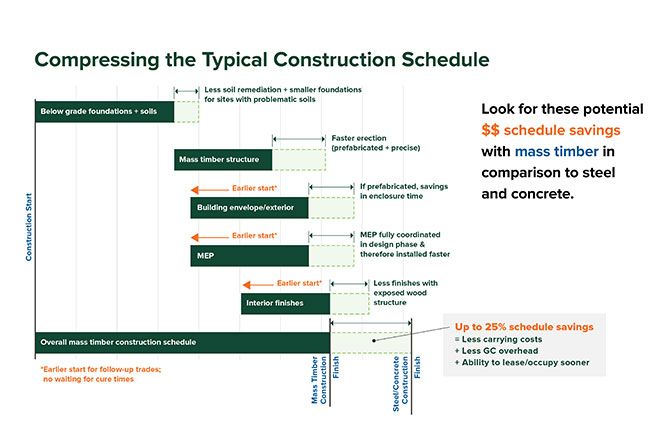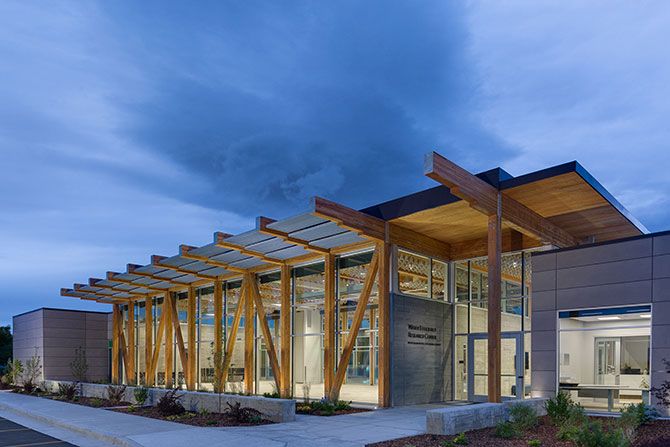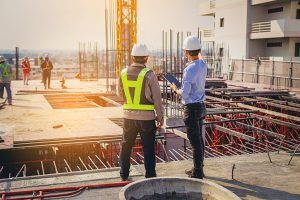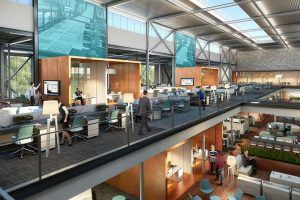Mass timber was introduced to the building market in the 1990s and has steadily become a popular and desired structural building system throughout the world. In Utah, it has been used sporadically for about a decade, though not as a mainstream structural system. Today, many professionals in the AE community are well aware of the basic concept and potential advantages of mass timber, having seen it used in projects across the county, and in the state. One question that lingers, as momentum grows, is “What is the long-term financial value of using a mass timber system, when the dollar-to-dollar hard-cost numbers, as compared to the equivalent system using steel or concrete, is potentially higher?” Keeping the focus strictly on the hard-cost comparison ignores the broader financial value that could make mass timber use a great long-term choice. The following are a few key factors to consider when looking at the long-term financial picture.
Market Differentiation
The unique sustainability and aesthetic advantages that the use of mass timber offers have always been at the forefront of its perceived value; however, there are financial advantages that come with its use as well. One of the advantages is the market differentiation that mass timber buildings afford. In a study by WoodWorks entitled “Mass Timber Business Case Studies,” it was found that office and multi-family buildings that are built with mass timber tend to “lease up faster than submarket norms, which translates to higher net incomes, lower income volatility, better internal rates of return, and better ability for owners to refinance or sell faster, creating an overall lower risk.” They also found that mass timber buildings tend to attract sought-after tenants, which translates to “better rent collection, lower cap rates, and more stable occupancy.” WoodWorks Representative Chelsea Drenick, who supports design teams in Utah, explains, “Generally, customers are becoming more sustainability-conscious and placing pressure on developers to lower the carbon footprint of new construction. The global focus on climate change could increasingly incentivize construction companies to factor sustainability into their projects, construction processes, and designs.” Though the initial hard cost of mass timber use can be higher than other options, the potential for market differentiation can be a significant financial value long-term.
Construction-Related Costs
A second key factor regarding the financial value of mass timber use is the reduction of the overall time of construction and, in turn, the reduction of the total project cost. This reduction is most magnified when the structural system is fully mass timber, as opposed to a hybrid system, as the pre-fabricated nature of mass timber parts allows for rapid erection time. Members are brought to the site pre-cut and ready for installation, where they are simply craned into place and secured on site. This allows the contractor to have fewer workers on site, erect the structure, and save overall project time. The financial savings due to reduced labor costs can be large if the time savings allow an owner to get into a space and start collecting revenue early.
In an article published by Think Wood, Douglas H. Evans and his colleagues assert, “An average of three case study comparisons, (a retail space, an office space, and a charter school), of mass timber buildings to conventional construction, showed an average of $5.81 per square foot in total cost reduction calculated on a 25% savings in the construction schedule. Reduced costs included saved interest on construction loans and additional rental income generated by earlier opening dates.” Similarly, the chart below, published by WoodWorks, illustrates the potential reduction in the construction schedule of that same 25% amount.

Source: Woodworks – Wood Products Council (woodworks.org)
Speaking of construction cost savings, there can also be significant time and labor involved with the selection, shipping, and installation of finish materials. Part of the beauty of specifying a mass timber structural system is that it can become the structure and the finish. Depending on the building type, size, and financial investments that would otherwise be used in ceiling clouds, wall finishes, coatings, etc., there can be substantial savings involved with this aspect of mass timber usage as well.
Increase in Productivity and Value
A third advantage of mass timber use that can have a long-term effect financially is its contribution to increased employee productivity and public health. In public buildings, owners understand that it is in their best interest, from a financial standpoint, to produce buildings that encourage health and quality of experience by incorporating nature into the space where possible. This principle of biophilic design has been studied by many researchers in the AE fields and beyond. Anthony Klotz, Associate Professor of Management at the University College of London, wrote in the MIT Sloan Management Review, “We spend about 92% of our lives indoors, on average,” and that as humans, “We still harbor a strong innate desire to be in contact with natural elements and processes. When we don’t [fulfill that desire] … we are more susceptible to stress, depression, and aggression.” Mass timber use in buildings allows for significant amounts of nature to be introduced to spaces for work, living, healing, playing, etc., and can largely contribute to the effects Klotz describes. The overall increase in productivity and value, though not a hard-cost savings item, can be a significant contributor to long-term financial value for owners and the public.
Conclusion
Though mass timber use has continued to grow in the Utah and Mountain West markets over the last decade, one question that lingers is “What is the holistic financial value of using a mass timber system, when the dollar-to-dollar numbers, as compared to the equivalent system using steel or concrete, is potentially higher? Is that value worth investing in?” Market differentiation, increase in productivity and value, and construction-related financial savings, are three pieces of that picture. Depending on the specifics of the project, these items should be worth careful consideration in future projects.








